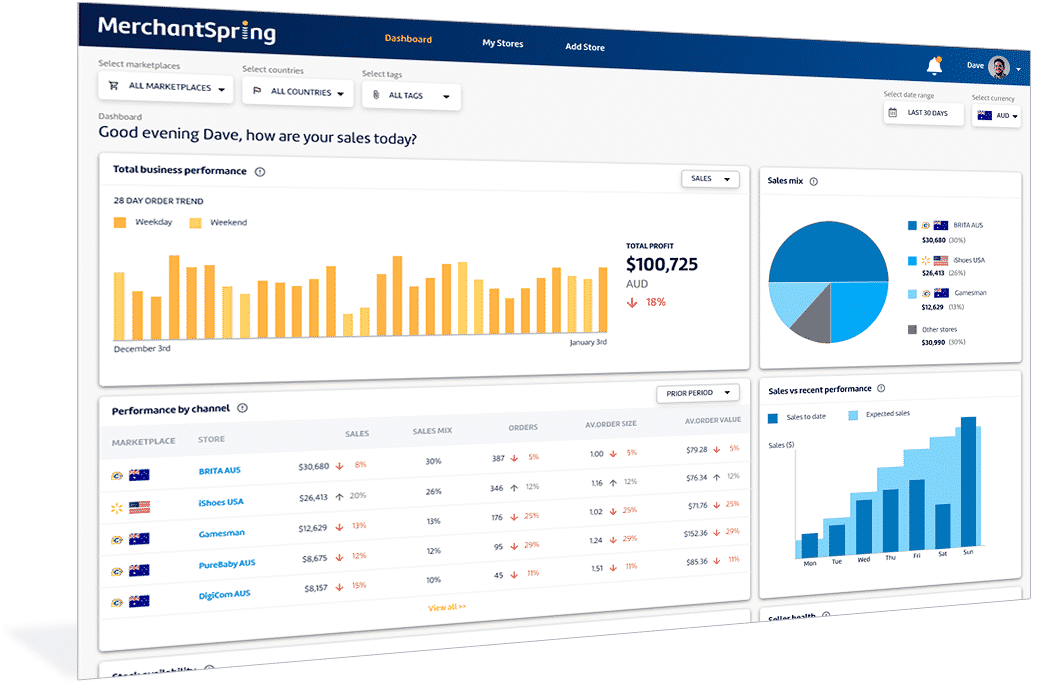The Next Marketplace Frontier: Walmart Awaits
Overview
If you’re an Amazon agency pro, you’ve likely mastered the art of selling on the world’s biggest marketplace. But what happens when your clients ask, “Can we expand to Walmart?” In 2025, this question isn’t a matter of if but when. Walmart’s online marketplace is no longer a backwater experiment – it’s a rapidly growing eCommerce arena with 34% quarterly growth in late 2024(marketplace.walmart.com) and an ecosystem that now reaches over 90% of U.S. households with same-day delivery(grocerydoppio.com). In short, the Walmart Marketplace is becoming impossible to ignore for ambitious brands and their agency partners.
For agencies that have thrived on Amazon, Walmart represents both a new challenge and a new opportunity. It’s a chance to diversify revenue, get in early on a platform that’s still maturing, and deliver big wins for clients beyond Amazon. This isn’t about abandoning Amazon’s dominance – it’s about embracing a cross-channel expansion strategy to stay ahead of the competition. In this playbook, we’ll break down exactly how to crack the Walmart code, from onboarding differences and Walmart SEO to advertising strategies on Walmart Connect and common mistakes to avoid. By the end, you’ll see why the top marketplace agencies are boldly venturing beyond Amazon and positioning Walmart as the next growth frontier for their clients.
“Walmart’s marketplace and advertising platform today are like Amazon was back in 2017.” – Hailee Johnson-Engelbert, Co-Founder of Cartbloom Media
Setting Expectations: Walmart is Not Amazon (And That’s OK)
First, let’s level-set expectations. Every Amazon veteran needs to hear this loud and clear: Walmart is not “Amazon 2.0.” The Walmart Marketplace is newer, less saturated, and still building out features – meaning your initial sales won’t match Amazon’s overnight. Hailee Johnson-Engelbert, a former Amazonian turned Walmart expert, advises agencies to remind clients of Amazon’s early days. Remember 2015-2017 on Amazon? Many brands were struggling to gain traction and questioning if Amazon would ever pay off. Today, Amazon is a juggernaut – and in Hailee’s words, “the Walmart marketplace platform…is like Amazon’s was at that point.” The growth curve is still ahead, which is exactly why now is the time to invest.
Bottom line: Set realistic goals for Walmart in Year 1. Expect lower GMV at first, but recognise you’re planting seeds in fertile ground. Walmart’s user base is exploding (especially among higher-income shoppers), and their eCommerce sales have seen double-digit growth for 11 consecutive quarters(marketplace.walmart.com). By getting your clients established on Walmart now, you position them to reap exponential rewards as the platform scales in the next 2–3 years. It’s the classic case of short-term patience for long-term payoff. Agencies that communicate this vision – and back it up with a solid Walmart strategy – will earn their clients’ trust and future growth.
The Onboarding Difference: Navigating Walmart’s Setup and Support
Shifting from Amazon to Walmart isn’t a simple copy-paste job. Walmart’s onboarding process and seller support ecosystem differ markedly from Amazon’s, and understanding those differences is key to a smooth launch.
- Seller Account Manager (SAM) – your secret weapon: Unlike Amazon, which charges hefty fees for dedicated account support, Walmart offers strategic sellers access to a Seller Account Manager (SAM) at no cost. If your brand is significant or you’re an agency aggregating volume, Walmart may assign you a SAM – essentially a free consultant inside Walmart. This person can assist with overall strategy, growth opportunities, and even unlock perks like commission discounts, fast-tracking Walmart Fulfillment Services (WFS) enrollment, or troubleshooting listing issues. As an agency, building a good relationship with the SAM can give you insider guidance that’s simply not available on Amazon without paying extra. Leverage them! They’ll help ensure your clients take full advantage of Walmart’s programs and avoid newbie mistakes.
- “Spec Sheet 5” and item setup: Another onboarding quirk is Walmart’s item setup file (often called the spec sheet). In mid-2025, Walmart rolled out Spec Sheet v5 – a spreadsheet for bulk uploading product listings. Warning: Don’t blindly copy your Amazon flat file into Walmart’s spec sheet! The required attributes and category taxonomy are different. Many Amazon-first sellers trip up here, using Amazon data fields that don’t align with Walmart’s, which leads to errors or miscategorised items.
Instead, carefully map your data to Walmart’s spec, line by line. Pay attention to Walmart-specific fields (like Product ID type defaults, compliance fields, etc.) and ensure accuracy from the start. Getting the catalog set up correctly is foundational to everything that follows – from SEO to advertising. Take the time to do it right (or use a partner tool or Walmart’s onboarding support if available). - Brand Registry and content governance: Just as with Amazon, brand registry on Walmart is crucial. The process is similar – you’ll need to prove your trademark and go through Walmart’s verification. The sooner you get brand approval, the sooner you unlock crucial tools like listing content control, Walmart Sponsored Brands ads, and Rich Media. Hailee recommends tackling this early in the onboarding phase (ideally immediately after your seller account is approved). If you’ve navigated Amazon’s brand registry, Walmart’s will feel familiar – but don’t procrastinate on it. Without brand registry, your content changes can be overwritten by others and your advertising capabilities will be limited.
- WFS vs. FBA – logistics considerations: Clients will inevitably ask how Walmart Fulfillment Services (WFS) compares to Fulfillment by Amazon (FBA). In strategy discussions, emphasise that WFS can be a game-changer for Walmart's success. WFS offers 2-day badged shipping to Walmart customers, boosting conversion much like Prime does on Amazon. Unlike Amazon, Walmart currently doesn’t charge a monthly fee – you only pay fulfillment fees per order, which on average are ~15% lower than FBA’s fees(marketplace.walmart.com).
Encourage clients to enroll key products in WFS to win the buy box (Walmart favours WFS offers in search ranking) and to meet the fast-delivery expectations of Walmart’s core shoppers. Be mindful of differences: for example, Walmart has strict rules on price parity – items should not be significantly pricier on Walmart than on Amazon or other sites. Your SAM can even assist with temporary commission breaks to improve margins during promotions, something Amazon wouldn’t dream of doing. All these onboarding nuances – from spec sheets to WFS – underscore a key point: succeeding on Walmart requires a dedicated approach, not an afterthought duplication of Amazon.
“It’s not something you can just throw together like Amazon. Walmart needs to be methodically planned with time and energy.” – Hailee Johnson-Engelbert
Walmart SEO & Content: Optimising for the Marketplace Algorithm
One of the biggest adjustments for Amazon-savvy sellers is relearning SEO and content optimisation for Walmart’s search algorithm. While many core eCommerce SEO principles carry over, Walmart has its own set of ranking factors and tools that agencies must master:
- Content Quality & the Listing Quality Score: On Walmart, content is king – arguably even more so than on Amazon. Walmart assigns each listing an Overall Listing Quality (OLQ) Score, which factors in content completeness, compliance, discoverability, ratings & reviews, and more. A high OLQ (target 80% or above) isn’t just for bragging rights; it directly impacts your organic search placement. For example, your title and description should include relevant keywords (just like Amazon SEO), but you also need correct category and attribute data or you won’t index for key searches.
Bullet points aren’t a thing on Walmart like Amazon; instead, focus on a concise, benefit-driven description and fill every attribute field you can (dimensions, materials, etc. – these feed Walmart’s search filters). Walmart’s algorithm rewards listings that are complete and accurate(marketplace.walmart.com). Use Walmart’s Listing Quality Dashboard to identify gaps. If you see your Content & Discoverability sub-score under 80%, address those issues ASAP (be it low-res images, missing attributes, or sparse descriptions). Consistently monitoring this score is now an essential part of Walmart marketplace SEO. - No review carry-overs – start collecting fresh reviews: One painful surprise for Amazon sellers moving to Walmart: you cannot port your 5,000 Amazon product reviews over to Walmart. (Walmart wants a level playing field.) The only reviews you might be able to transfer are from your own D2C site, via a review syndication partner, but Amazon reviews are off-limits. This means you must have a strategy to build review volume from scratch on Walmart.
Encourage clients to enroll in Walmart’s Review Accelerator program or run campaigns to their customer base for honest reviews. Early on, even a few 5-star reviews make a difference in conversion. And remember, Walmart shoppers are very price-sensitive and value-focused, so ratings greatly influence the algorithm. Tackling reviews is part of being retail-ready on Walmart – just as crucial as on Amazon. - SEO differences and keyword research: While Amazon’s A9 algorithm is mature and picky, Walmart’s search is still evolving. Some anecdotal insights from Walmart experts: exact match keywords in your title seem to carry significant weight. However, don’t keyword-stuff – Walmart’s content guidelines favour a clean title format (Brand + Product + Key Specs). Backend keywords exist (via Search Boost attributes,) but keep them relevant – unlike Amazon, Walmart will penalise irrelevant keywords quickly.
Also, factor in Walmart’s demographic: trending keywords on Walmart might differ slightly. Use Walmart’s auto-suggest in the search bar for ideas, and note that Walmart Connect’s Search Brand Amplifier ads can also signal high-value keywords. In short, apply your SEO skills, but calibrate them to Walmart’s rules and shopper behaviour. One pro tip: utilise Walmart’s Search Engine Marketing (SEM) program – Walmart has a beta where they run Google Shopping ads for your listings (you often see “Sold by Walmart.com” on Google results). Participating can drive external traffic that boosts your listing’s performance and organic rank over time. External traffic is an increasingly important lever for Walmart SEO, so don’t neglect it if it fits your client’s budget. - Price parity and promos: Last but not least, Walmart cares a lot about price competitiveness. If your item is $19.99 on Amazon but $24.99 on Walmart, don’t be surprised if your Walmart organic rank is suppressed or the item even gets delisted. Advise clients that price parity (or lower) is crucial when expanding to Walmart. It might mean trimming margins or negotiating supplier costs, but it’s the cost of entry for success.
Plan promotions around Walmart’s big events too – e.g. Walmart’s “July Savings” (their answer to Prime Day) or “Black Friday Deals for Days.” Walmart will often highlight marketplace sellers who offer great deals during these windows, driving a flood of traffic. A strategic promo can spike sales, which in turn generates more reviews and boosts your organic momentum post-sale. It’s all interconnected in the Walmart flywheel.
Cracking Walmart Connect: Advertising Strategies that Work
No Amazon expansion playbook is complete without addressing advertising. On Amazon, agencies live and breathe PPC optimisation – and now Walmart’s advertising platform (Walmart Connect) demands that same level of attention. The good news? Walmart’s ad ecosystem is familiar in structure (sponsored products, brands, display, etc.). The challenge? It’s not as mature, meaning you need to adjust tactics and expectations.
- Walmart’s ad arsenal – similar tools, earlier stage: Walmart Connect’s self-serve platform offers Sponsored Products (auto & manual), Sponsored Brands (banner ads showcasing a brand logo and products), Sponsored Videos, and a nascent Display Ads program for brand-registered sellers. If that sounds like Amazon circa 2019, you’re right – Hailee pegs Walmart’s ad platform as roughly “where Amazon’s was a few years ago.” In practice, this means two things: fewer ad types (no DSP for self-serve, for instance), and lots of opportunity, as many competitors aren’t sophisticated yet.
Cost-per-click on Walmart is often significantly cheaper than Amazon for comparable keywords, partly because Walmart has less competition and partly due to still-growing traffic. This is a golden window for your clients to grab market share with efficient ad spend. Make sure they’re brand-registered to unlock all ad units. Then, implement a structure with plenty of Sponsored Product campaigns – they are the workhorse of Walmart Connect and will drive the bulk of your paid sales. - Rethink your Amazon PPC playbook: When copying over campaigns from Amazon, don’t assume a 1:1 transfer will yield results. For one, Walmart’s algorithm and reporting have quirks – for example, placement adjustments are not as evolved, and there’s no exact same dayparting or budget rules yet. Secondly, Walmart’s advertising ties into listing quality; if your content score is poor, your ads might not even serve for certain queries.
The strategy that works is a progressive build: start with a few core auto campaigns to let Walmart’s algorithm identify relevant search terms. Then, harvest keywords from those auto campaigns and from Walmart’s search query performance reports to fuel manual campaigns. Hailee suggests regularly mining search terms and moving winners into exact match manual campaigns for control. Also, don’t overlook Browse (category) campaigns – Walmart allows category targeting, which can be useful for broad exposure if your category isn’t too crowded. - Budgeting and bidding tips: One big difference: Walmart lets you set bid multipliers for placement (e.g. up to +900% for search page top). Early on, consider boosting bids for the top search placement – it can dramatically increase visibility for new products. Just watch spend closely. Unlike Amazon, Walmart doesn’t yet have a robust negative keyword system (they have filters, but it’s clunky), so monitor your auto campaigns and pause any irrelevant products or keywords that eat spend.
In terms of budgeting, advise clients that Walmart may require a smaller absolute budget at first, but it should be seen as an incremental investment in growth. The ROI might not match their Amazon ACOS initially (different stage of market), so set ACOS/ROAS expectations accordingly. The goal is to gain traction and data, not to hit a 5% ACOS out of the gate. As your campaigns optimise, Walmart ads can become very efficient – especially since organically ranking on Walmart is easier once ads drive a sales history. It’s a virtuous cycle: ads boost sales, which boost organic rank, which leads to more sales. - External and advanced ads: In addition to Walmart Connect, don’t forget external advertising. Walmart now encourages sellers to drive outside traffic by providing attribution tracking and even rebates on ad spend through their platform for Google Ads (the Search Engine Marketing program in Seller Centre). Using Google Shopping ads or social media to send users to Walmart can not only convert directly but also enhance your Walmart listing’s standing (the algorithm rewards listings that draw traffic). If your client has a D2C presence, also coordinate promotions to nudge some of that audience to purchase on Walmart – especially for product launches to get the flywheel moving.
On the advanced side, Walmart’s advertising platform is evolving monthly. New features like search brand amplifiers (akin to Amazon’s headline search ads) and display retargeting are rolling out. Stay in touch with your Walmart reps or news from Walmart Connect so your agency is on the cutting edge of any new ad capabilities. Mastering Walmart advertising early is a killer advantage; many agencies are still asleep at the wheel, treating Walmart like a rounding error. You can be the one driving major growth with savvy PPC on a platform-wide open for experts.
Winning Strategies for Walmart Success (What Amazon Agencies Must Do)
Having covered the mechanics, let’s zoom out to strategy. For an Amazon-focused agency to truly succeed on Walmart, it requires a shift in mindset and approach. Here are key strategic pillars to implement:
- Dedicate Ownership and Resources: Don’t treat Walmart as a side project. Assign a specific team member (or team) to become your Walmart marketplace strategy lead. They should immerse in Walmart’s portal, attend Walmart’s webinars, read Walmart’s “Sell Better Blog,” and essentially become as fluent in Walmart-speak as your other staff are with Amazon. This dedicated focus ensures that nuances (like the ones we’ve discussed: spec sheets, OLQ scores, etc.) are not overlooked. It also sends a message to clients that you take Walmart seriously. Some agencies even spin up a separate Walmart division – you might not need to go that far, but do ensure clear ownership of Walmart success internally.
- Leverage Walmart’s Human Support: We mentioned the SAM program – use it. Additionally, Walmart’s support teams (both marketplace and Walmart Connect) are known to be more accessible than Amazon’s. As Hailee noted from her experience, brands often feel they “have access to people” at Walmart that simply isn’t possible at Amazon’s scale. So, if an issue arises – an unjustified listing suspension, an ad serving bug, etc. – don’t hesitate to reach out to Walmart seller support or your account manager. They can often fix or escalate issues in a way Amazon’s ticket system would never do. Building these human relationships is part of being successful on Walmart. Attend Walmart’s Seller Summit events, network on LinkedIn with Walmart marketplace staff, and get your agency on Walmart’s radar as a serious partner. These connections might land your client a beta test opportunity or early access to new features (a huge leg up!).
- Embrace Data (even when sparse): Coming from Amazon’s rich analytics, Walmart’s data views might feel Spartan. But there’s still plenty to glean. Dive into Walmart’s Business Report for sales, the Listing Quality Dashboard for content metrics, and Advertising reports for keyword performance. Over time, compile benchmarks: What’s a good conversion rate on Walmart in your client’s category? How does ad ROAS trend as review count grows? Use these insights to educate clients on progress.
For instance, you might report, “Organic sessions are up 50% month-on-month after we raised the listing quality score from 70% to 95%.” That ties your tactical work to tangible outcomes. Being analytical and data-backed in your Walmart approach will set you apart, as many are still guessing. If something’s unclear, test it. For example, run an A/B test on a title optimisation or a main image change (Walmart now supports variant listing experiments in some cases). Apply the same rigour you do on Amazon – it works here too, even if the tools differ. - Holistic Marketplace Strategy: The most successful agencies don’t silo Amazon and Walmart – they craft a unified commerce strategy where each channel has a role. Use insights from one to feed the other. Best-selling Amazon product out of stock? Maybe you can route shoppers to Walmart to buy it there (and vice versa) to keep sales flowing. Coordinated launch of a new product on both Amazon and Walmart? Plan the campaigns to complement each other (perhaps Amazon gets more budget but Walmart gets a price promo to entice early reviews).
Additionally, educate brands on Walmart’s unique strengths: Walmart.com can be a gateway to in-store stocking (Walmart’s buyers often scout marketplace products to bring into physical stores). If your client’s goal is omnichannel, performing well on Walmart Marketplace could be a stepping stone to a retail deal – a huge incentive. Also, Walmart’s audience skews towards everyday low price shoppers; maybe products that struggled on premium-priced Amazon could thrive in Walmart’s value-centric environment. Think strategically about assortment: what products to list (or even create) specifically for Walmart’s customer base. This higher-level strategic thinking – beyond just “list and run ads” – turns your agency from a service vendor into a trusted advisor as clients navigate multi-market growth.
Common Mistakes (and How to Avoid Them)
Even top Amazon agencies can stub their toe on Walmart if they carry over assumptions wholesale. Here are the most common mistakes Amazon-first sellers make on Walmart – and how to avoid them:
- Mirroring Amazon Strategies without Adaptation: As we’ve stressed, Walmart is its own beast. Simply duplicating your Amazon listings, keywords, and PPC campaigns to Walmart and then feeling disappointed by poor results is a recipe for failure. Avoid this by treating the Walmart launch as a distinct project: do fresh keyword research on Walmart, rewrite content to fit Walmart’s style guidelines, and build campaigns aligned to Walmart’s different auction dynamics. What works on Amazon might flop on Walmart if not tweaked.
- Ignoring Content & Quality Scores: Some sellers assume that because Walmart is newer, they can get away with mediocre content or minimal optimisation. In reality, those who thrive on Walmart are the ones aggressively optimising content from day one. Don’t ignore your Listing Quality Score – if it’s low, fix it. Don’t list half your catalogue and “see how it goes” without proper titles and images. Walmart will bury low-quality listings. Invest the same level of polish in Walmart listings as you do on Amazon, even if the volume is initially lower. This upfront work sets you up to climb organically.
- Impatience and Neglect: The flip side of setting expectations is some agencies give up too soon. They list a client on Walmart, two months in, sales are lacklustre, so they stop paying attention. This is a huge mistake. Walmart requires a longer-term view. If something isn’t working, diagnose it – is it lack of reviews? Low ad spend? Category misplacement? Treat it as an ongoing effort, not a “set and forget.” And certainly don’t just check in once a quarter. The marketplace is growing and changing quickly; consistent attention is needed to catch opportunities (e.g. a new category opens up, or a competitor runs out of stock – moments you capitalise on, but only if you’re watching).
- Overestimating “easy” wins: Lastly, don’t assume Walmart will be easy money. Yes, competition is less intense, but that doesn’t mean customers will automatically flock to your product. Many Amazon habits (like ultra-aggressive pricing, Prime-like fulfillment, etc.) still apply. Earn Walmart success through strategy and effort – there’s no guaranteed free lunch. The brands that treat Walmart seriously are pulling in significant new revenue; those that list a few SKUs half-heartedly often see the “Walmart doesn’t work for us” outcome.
Avoiding these pitfalls comes down to one principle: respect Walmart as a major platform in its own right. Approach it with curiosity, allocate talent and budget to it, and be willing to iterate. Do this, and Walmart can become a growth engine for your agency and your clients – not just an afterthought channel.
Category and Growth Snapshot: Where Walmart Shines Right Now
What kinds of brands stand to gain the most from Walmart Marketplace in 2025? The short answer: almost every category has opportunity, but a few standouts are emerging.
Walmart’s heritage is grocery and household essentials – unsurprisingly, those categories drive massive volume online now, especially with Walmart’s same-day delivery capabilities. If your clients are in Food & Beverage or CPG, Walmart.com is a must (and a gateway to store distribution potentially). But beyond grocery, Walmart’s marketplace has exploded in general merchandise. Fashion is a surprise winner – Walmart has made big pushes to expand apparel offerings, and some marketplace fashion sellers have grown to seven and eight figures annually with Walmart’s support. Home goods is another hot category, aligning with Walmart’s broad store assortment in home decor, furniture, and appliances. We’ve seen brands in these spaces quickly become top sellers on Walmart because the competition was sparse a couple of years ago, and they grabbed the first-mover advantage.
That said, don’t rule out any category. Whether it’s electronics, toys, sporting goods, beauty, or even niche collectibles, Walmart is investing in site experiences to cater to them (e.g. a dedicated Collectors hub for trading cards and comics(marketplace.walmart.com), or a Premium Beauty section to attract higher-end cosmetics(marketplace.walmart.com)). Walmart’s customer base is also broadening – it’s not just budget-conscious shoppers. Many higher-income consumers started shopping at Walmart during recent economic shifts and discovered the convenience and value, making Walmart a habit. In fact, Walmart’s gains in eCommerce are partly driven by new, wealthier customers coming in for essentials and staying to buy across categories(marketplace.walmart.com).
For agencies, this means no matter your client’s niche, it’s worth exploring Walmart. The key is to study Walmart’s core shopper expectations in that category. For example, a premium $300 cookware set might need a slightly different positioning on Walmart (emphasising value and durability) than on Amazon. If a category is nascent on Walmart, that’s an invitation to become a category leader. If it’s crowded, you can bet Walmart is still underpenetrated compared to Amazon’s share, so there’s room to steal customers with a better offer or presentation.
In short, there’s opportunity in every category on Walmart – the deciding factors will be your strategy, pricing, and commitment. As Hailee succinctly put it:
“I believe today that there’s opportunity in every category. It’s just about the strategy, the price point, and the investment that you are willing to make into your Walmart Marketplace strategy.”
Focus on those levers, and any brand can find its audience on Walmart’s growing platform.
Conclusion: Embrace the Walmart Wave – Your Clients Will Thank You
For Amazon-centric agencies, Walmart’s marketplace represents the next great growth frontier. It’s a chance to apply your hard-won marketplace expertise in a new arena where the rules are different, but the rewards can be substantial. Yes, it requires dedication and a tailored game plan, but that’s exactly why your agency’s involvement is so valuable. By guiding your clients onto Walmart before their competitors, you position them (and yourself) as marketplace leaders across channels – the kind of bold, future-proof partners that brands crave.
As Walmart continues to invest billions in eCommerce, advertising, and seller support, the agencies who master this platform now will be the ones reaping the benefits for years to come. The Walmart wave is building – don’t wait until it crests to jump on. Start with the steps in this playbook: set expectations, get the onboarding right, optimize content religiously, leverage Walmart Connect ads, avoid Amazon-first pitfalls, and constantly refine your strategy with data. In doing so, you’ll not only drive new revenue streams for your clients but also strengthen your agency’s reputation as an innovative, authoritative guide in the marketplace space.
Ready to accelerate your clients’ growth on Walmart? Watch the full webinar recording with Hailee Johnson-Engelbert for an insider walkthrough of Walmart's best practices, or contact our team at MerchantSpring for help implementing a winning Walmart strategy. Don’t let your clients miss out on the Walmart momentum – seize the opportunity and lead the way. Your next marketplace success story awaits on Walmart.com!


%206-1.png)











Add a Comment